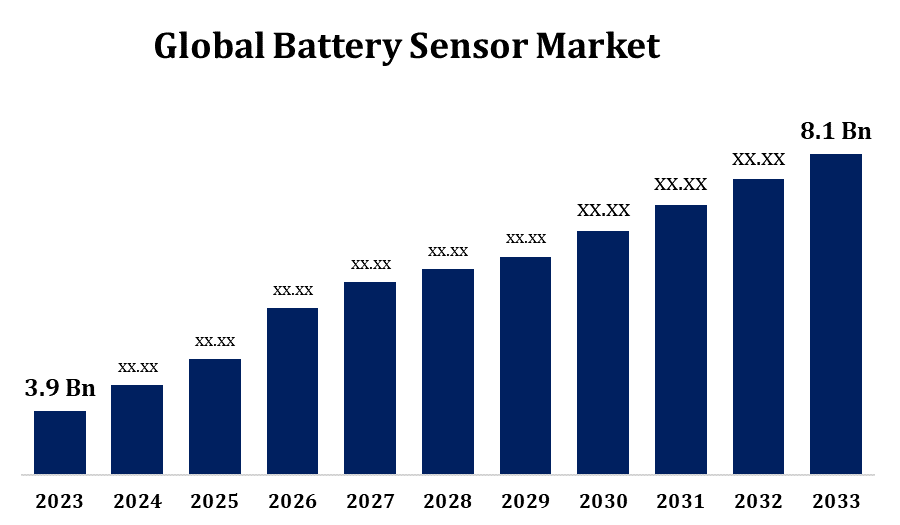Global Battery Sensor Market Size, Share, and COVID-19 Impact Analysis, By Voltage Type (12V, 24V), By Communication (LIN, CAN), By Vehicle Type (Passenger cars, Light Commercial Vehicles), By Hybrid Type (HEV and PHEV), and By Region (North America, Europe, Asia-Pacific, Latin America, Middle East, and Africa), Analysis and Forecast 2023 - 2033
Industry: Semiconductors & ElectronicsGlobal Battery Sensor Market Insights Forecasts To 2033
- The Global Battery Sensor Market Size was valued At USD 3.9 Billion in 2023.
- The Market is Growing at a CAGR of 7.58% from 2023 to 2033.
- The Worldwide Battery Sensor Market Size is Expected to reach USD 8.1 Billion by 2033.
- Asia Pacific is Expected to Grow the fastest during the forecast period.

Get more details on this report -
The Global Battery Sensor Market Size is Expected to reach USD 8.1 Billion by 2033, at a CAGR of 7.58% during the forecast period 2023 to 2033.
The battery sensor market is experiencing rapid growth due to the increasing demand for efficient and reliable energy storage systems, particularly in electric vehicles (EVs) and renewable energy applications. These sensors monitor various battery parameters, including voltage, temperature, and state of charge, ensuring optimal performance, safety, and longevity. The market is driven by advancements in battery technology, with manufacturers focusing on improving energy density and performance. Additionally, stringent regulations related to battery safety are propelling the adoption of battery sensors in automotive, consumer electronics, and industrial applications. As the shift towards sustainable energy solutions accelerates, the demand for intelligent battery management systems (BMS) incorporating advanced sensor technologies is expected to expand. This trend is further supported by ongoing innovations in the sensor technologies themselves, enhancing their accuracy and reliability.
Battery Sensor Market Value Chain Analysis
The battery sensor market value chain involves several key stages, starting with raw material procurement, including components like metals, semiconductors, and sensors. Manufacturers then design and produce battery sensors, incorporating advanced technologies for monitoring key parameters such as voltage, temperature, and state of charge. The sensors are integrated into battery management systems (BMS), which are crucial for applications like electric vehicles (EVs), consumer electronics, and renewable energy systems. Distribution networks and supply chain management play a significant role in delivering these sensors to various industries. End-users, such as automotive OEMs, electronics manufacturers, and energy providers, implement the sensors into their products for enhanced performance and safety. Finally, service providers focus on sensor maintenance and upgrades, ensuring the longevity and accuracy of the sensors over time.
Battery Sensor Market Opportunity Analysis
The battery sensor market is experiencing significant growth, propelled by the increasing adoption of electric vehicles (EVs) and advancements in battery management systems (BMS). These sensors are essential for monitoring battery health, ensuring optimal performance, and extending lifespan. The integration of artificial intelligence (AI) and machine learning (ML) into battery sensors offers predictive analytics, enhancing proactive maintenance and energy efficiency. Moreover, the convergence of battery sensors with the Internet of Things (IoT) and telematics systems facilitates real-time monitoring and data analytics, providing valuable insights into battery performance. In emerging markets across Asia-Pacific, Latin America, and Africa, the growing adoption of EVs and renewable energy systems presents substantial opportunities for battery sensor manufacturers to offer tailored, cost-effective solutions.
Battery Sensor Market Report Coverage
| Report Coverage | Details |
|---|---|
| Base Year: | 2023 |
| Market Size in 2023: | USD 3.9 Billion |
| Forecast Period: | 2023-2033 |
| Forecast Period CAGR 2023-2033 : | 7.58% |
| 2033 Value Projection: | USD 8.1 Billion |
| Historical Data for: | 2019-2022 |
| No. of Pages: | 240 |
| Tables, Charts & Figures: | 116 |
| Segments covered: | By Voltage Type , By Communication, By Vehicle Type, By Hybrid, By Region and COVID-19 Impact Analysis |
| Companies covered:: | HELLA (Germany), Continental (Germany), Bosch (Germany), Furukawa Electric (Japan), NXP (Netherlands), Vishay (US), Texas Instrument (US), Denso (Japan), ams AG (Austria), Inomatic (Germany), TE Connectivity (Switzerland), and Others Key HELLA (Germany), Continental (Germany), Bosch (Germany), Furukawa Electric (Japan), NXP (Netherlands), Vishay (US), Texas Instrument (US), Denso (Japan), ams AG (Austria), Inomatic (Germany), TE Connectivity (Switzerland), and Vendors. |
| Pitfalls & Challenges: | COVID-19 Empact, Challenge, Future, Growth, & Analysis. |
Get more details on this report -
Market Dynamics
Battery Sensor Market Dynamics
Enhanced battery performance and efficiency to drive the market growth
The growth of the battery sensor market is largely driven by the increasing demand for enhanced battery performance and efficiency. As industries like electric vehicles (EVs), consumer electronics, and renewable energy systems continue to expand, the need for more reliable and efficient battery solutions becomes crucial. Battery sensors play a key role in monitoring parameters such as temperature, voltage, and state of charge, helping optimize performance and extend battery life. With advancements in sensor technology, manufacturers are focusing on improving the accuracy and functionality of these sensors, enabling better battery management. As the global push for sustainable energy solutions intensifies, the adoption of battery sensors integrated into smart battery management systems (BMS) is expected to accelerate, driving further market growth.
Restraints & Challenges
A key obstacle is the high initial investment required for advanced sensor technologies, which can be a barrier for smaller businesses and cost-sensitive markets. Additionally, the lack of standardized regulations and protocols across industries leads to compatibility issues, complicating sensor integration. Technological complexities also pose a challenge, as integrating sensors into existing systems requires specialized knowledge and expertise. Moreover, concerns around data privacy and cybersecurity arise, as sensors collect and transmit sensitive data, making them vulnerable to cyber threats. The rise of counterfeit products in the market, which lack durability and quality, further affects consumer trust.
Regional Forecasts
North America Market Statistics

Get more details on this report -
North America is anticipated to dominate the Battery Sensor Market from 2023 to 2033. The increasing focus on energy efficiency and sustainability in the automotive, consumer electronics, and renewable energy sectors is further boosting the market. As regulatory standards around emissions tighten, manufacturers are seeking innovative solutions to optimize battery performance, safety, and lifespan, which is fueling the demand for battery sensors. Additionally, the growing investments in EV infrastructure, including charging stations, and the shift toward cleaner energy sources contribute to the expansion of the battery sensor market in the region. As technological advancements continue, North America remains a key player in the development and deployment of next-generation battery sensor solutions.
Asia Pacific Market Statistics
Asia Pacific is witnessing the fastest market growth between 2023 to 2033. The region's strong manufacturing base, coupled with supportive government policies promoting clean energy, has accelerated the demand for efficient battery solutions. Countries like China, Japan, and South Korea are at the forefront, investing heavily in EV infrastructure and battery technologies. China, in particular, dominates the market, with significant contributions from leading companies such as BYD and CATL. The integration of intelligent battery sensors in EVs enhances performance, safety, and lifespan, further fueling market expansion. As technological innovations continue and consumer demand for sustainable transportation rises, the Asia Pacific battery sensor market is poised for continued growth in the coming years.
Segmentation Analysis
Insights by Voltage Type
The 12V segment accounted for the largest market share over the forecast period 2023 to 2033. The growth is driven by its widespread use in internal combustion engine (ICE) vehicles, hybrid electric vehicles (HEVs), and entry-level electric vehicles (EVs). This growth is attributed to the increasing demand for fuel-efficient vehicles, stringent emission regulations, and the adoption of technologies like regenerative braking and start/stop systems. 12V battery sensors play a crucial role in monitoring battery health, state of charge, and state of function, thereby enhancing vehicle performance and longevity. The segment's expansion is further supported by the rising production of passenger cars and the growing emphasis on reducing CO emissions in the automotive industry.
Insights by Communication
The CAN segment accounted for the largest market share over the forecast period 2023 to 2033. CAN technology facilitates reliable and high-speed data communication between battery sensors, battery management systems (BMS), and electronic control units (ECUs), enabling real-time monitoring of critical battery parameters such as voltage, temperature, and current. This is crucial for optimizing battery performance, improving safety, and extending battery life. The widespread use of CAN technology in advanced automotive applications has contributed to its strong market presence. As the automotive industry shifts toward electrification and incorporates more advanced driver-assistance systems (ADAS), the demand for CAN-based battery sensors is expected to continue growing, solidifying their importance in modern vehicle systems.
Insights by Vehicle Type
The passenger car segment accounted for the largest market share over the forecast period 2023 to 2033. As consumers shift toward more eco-friendly transportation options, the need for efficient and reliable battery management systems (BMS) becomes essential. Battery sensors are integrated into these systems to monitor key parameters like voltage, temperature, and state of charge, ensuring optimal performance and extending the life of the battery. Additionally, stricter emission regulations are pushing manufacturers to adopt advanced battery technologies. As the automotive industry continues to prioritize sustainability and innovation, the demand for battery sensors in passenger cars is expected to rise, reinforcing their importance in improving vehicle performance, safety, and energy efficiency.
Insights by Hybrid Type
The HEV segment accounted for the largest market share over the forecast period 2023 to 2033. The growth is driven by the increasing adoption of vehicles that combine internal combustion engines with electric propulsion. HEVs require sophisticated battery sensors to efficiently manage energy flows between the engine, battery, and electric motor. As automotive manufacturers enhance hybrid technology for improved fuel efficiency and reduced emissions, the demand for advanced battery sensors to optimize hybrid system performance is increasing. This trend is expected to continue, contributing to the expansion of the battery sensor market in the HEV segment.
Recent Market Developments
- In May 2022, Continental has introduced advanced sensors designed to protect batteries in electrified vehicles. The high-voltage Current Sensor Module (CSM) provides precise current and temperature data, helping to ensure battery safety and extend its lifespan.
Competitive Landscape
Major players in the market
- HELLA (Germany)
- Continental (Germany)
- Bosch (Germany)
- Furukawa Electric (Japan)
- NXP (Netherlands)
- Vishay (US)
- Texas Instrument (US)
- Denso (Japan)
- ams AG (Austria)
- Inomatic (Germany)
- TE Connectivity (Switzerland)
Market Segmentation
This study forecasts revenue at global, regional, and country levels from 2023 to 2033.
Battery Sensor Market, Voltage Type Analysis
- 12V
- 24V
Battery Sensor Market, Communication Analysis
- LIN
- CAN
Battery Sensor Market, Vehicle Type Analysis
- Passenger cars
- Light Commercial Vehicles
Battery Sensor Market, Hybrid Type Analysis
- HEV
- PHEV
Battery Sensor Market, Regional Analysis
- North America
- US
- Canada
- Mexico
- Europe
- Germany
- Uk
- France
- Italy
- Spain
- Russia
- Rest of Europe
- Asia Pacific
- China
- Japan
- India
- South Korea
- Australia
- Rest of Asia Pacific
- South America
- Brazil
- Argentina
- Rest of South America
- Middle East & Africa
- UAE
- Saudi Arabia
- Qatar
- South Africa
- Rest of the Middle East & Africa
Need help to buy this report?